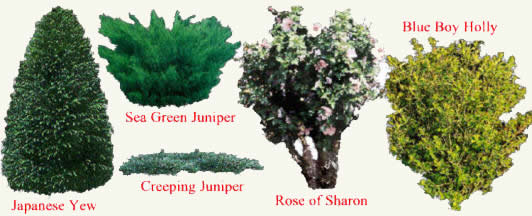
Woody plants with a mature height of less than 20 feet are usually classified as shrubs. Shrubs have branches coming from the base and their special merit is demonstrated in the nature and colour of foliage, flower, their shape and display of colorful fruit.
Plants are used to:
- Provide major landscape features
- Provide a space or screen a view
- Accentuate or soften the shape of a building
- Create a contrast or establish unity; with color, shape or texture
- Create interest by using exotic materials

Consider the following characteristics when selecting plants:
- Suitability (hardiness)
- Mature size
- Flowering habits
- Seasonal change
- Susceptibility to insect and disease damage
- Environmental requirements of the plants
- Maintenance requirements such as pruning
Shrubs with Attractive Fruits:
In most cases shrubs are grown for the beauty of their flowers, but many have fruits that are ornamental. Fruits also provide food for birds. It should be noted that some shrubs have sexes on separate plants so both male and female are required for fruiting to occur.
Choosing the right shrub for your landscape:
There are hundreds if not thousands of species and variations of species of shrubs and it would be impossible to list everyone. Table 1 represents the most common shrubs, there attributes, colors, advantages and disadvantages.
| Table 1 - The Most Common Shrubs With Their Attributes | |||
Siberian Crabapple:
|
Highbush Cranberry:
|
Red-osier Dogwood:
|
Sea-buckthorn:
|
| Other shrubs with colorful fruit: | |||
Red:
|
Blue:
|
Black:
|
Purple:
|
Shrubs with colorful foliage: Colorful foliage provides a main or added attraction in shrubs and usually lasts longer than flowers. |
|||
|
|
|
|
|
|
Other shrubs with colorful foliage: | |
|
Sea-Buckthorn - silver grey Russian Olive - silver grey Royalty Crabapple - purple Cistena Cherry - purple |
Golden Ninebark - yellow Golden Leaf Mock Orange - yellow Golden Leaf Dogwood - yellow/green |
||
